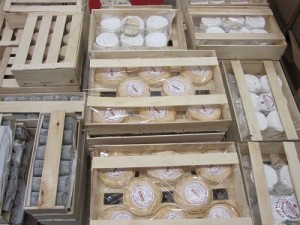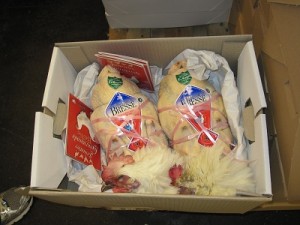Have you ever had Camembert? I am sure you are all nodding. Thinking, “ Yes, but not the most interesting of cheeses.” That’s what I was thinking when I saw we had almost an entire day devoted to Camembert. How wrong I was. I had never had AOC Camembert. REAL Camembert, from Normandy.
Our Camembert day takes place at the Universite de la Sorbonne, a magnificent prestigious setting to discuss this French delicacy and what it means to protect truly French products.
In 1791 in the tiny Norman village of Camembert, Marie Harel invented a bloomy rind cheese. It’s by no means the oldest cheese in France, but it was the one of the first of the industrial era. Students of the famous Louis Pasteur worked with Marie and others to master the art of fermentation and used the most modern production techniques of the times. Camembert’s popularity grew quickly, thanks to the railway to Paris. Increased popularity encouraged more and more producers to make the cheese, and by the 20th century it was being replicated in USA, Denmark and Germany.
All the producers in Normandy were concerned that “their” cheese was being made all over the world. It just was not the same as what they were making. Some of the cheeses were giving theirs a bad name. They founded an association in 1905, and after many, many attempts got protected designation for “Camembert de Normandy” in 1983. Talk about persistent, and believing in your product!
To qualify as Camembert de Normandy, it must be made in Normandy, with raw milk, deposited using a ladle, and sold in a wooden box. Producers must use Norman cows allowed to graze on grassy pastures. Only penicillium could be used for fermentation. Pretty specific. Anything less is just Camembert, NOT Camembert de Normandy, an AOC (Appellation D’Origine Controlee).

The AOC designation means that only a certain product (following exacting criteria) can be called by a certain name. The producers must prove that it is not only the recipe, but the PLACE a product is made that makes it unique. The “terroir” (the place) is a determining factor. The Camembert producers had to prove that even following the recipe but not in Normandy, would result in a different cheese.
Imagine. Fighting to protect a cheese for seventy-eight years. And the battle goes on, one large producer in France fighting to use heat treated instead of raw milk in its Camembert de Normandy.
I resist the temptation to ask the professor “Seems like an awful lot of work, this AOC designation. Is it really worth it?” He is incredibly passionate about his subject, his voice escalating, his fist pounding the table when describing the battles to protect Camembert from the dreaded heat treated or even worse (gasp) pasteurized milk.
And then, we taste. Seriously. This cheese was “a point”. Perfect. Room temperature. Lovely and oozy and ripe, with a still barely chaulky core. It is rich and full of flavour, no mistaking the raw milk used. And by the way, any Camembert I had encountered up until now, like a piece of Styrofoam insulation in comparison. I too am now ready to defend Camembert! I will protest in the streets at the mere mention of the use of heat treated milk!

This is one cheese. One AOC cheese. There forty six of them. For wines and spirits there are 364 AOC varieties. 2 for honey. 2 for poultry….even one AOC designation for fodder for cattle in the south of France. Behind each one a collective that believed so strongly in their product that they banded together, created an identity, methodology, a recipe for their product, and then fought (some for many years) to get recognition, to win the AOC designation, so they could stand together proudly behind their product. To protect it, for generations to come.
Instead of wondering was it all really worth it, I wondered what do we have in Canada to protect? Are we protecting it? Would producers fight for it for seventy eight years?
Someone brave gathered up the courage to ask “Isn’t this AOC – this restricting others to make the same products….isn’t it a form of protectionism?”
“But of course! What is wrong with protecting what you invented?”
What is wrong with it? I still can’t think of a uniquely Canadian product worthy of protection, and feel terrible about it. I don’t think we’d ever find a professor in Canada pounding his fist over the protection of the Tim’s Double Double. For the lack of products to protect, and the lack of passion to protect them, I am a little sad, and a little envious of the French.
